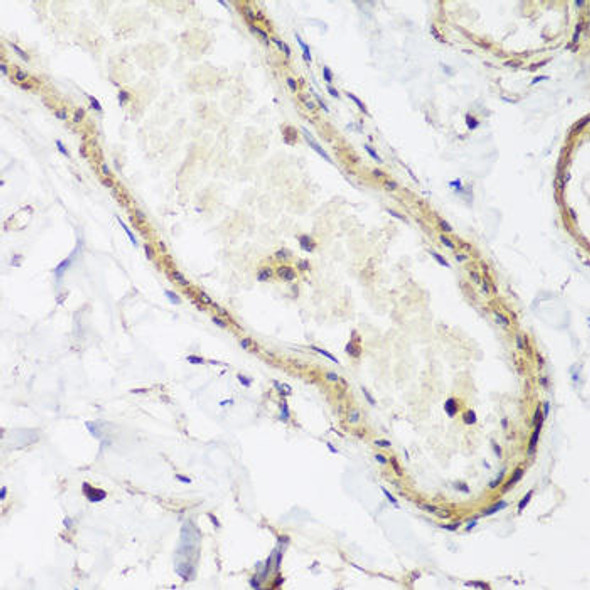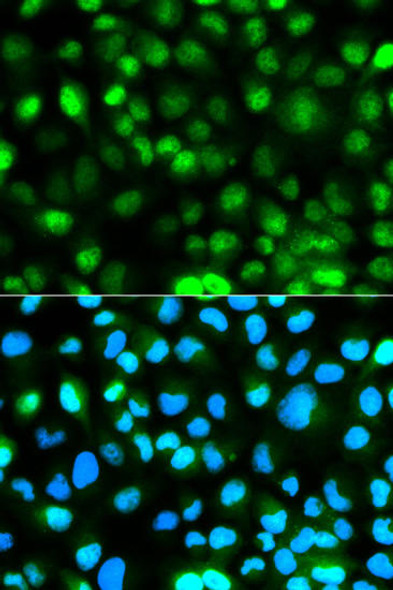Description
| Product Name: | Neuregulin-3 (NRG3) Rabbit mAb |
| Product Code: | CAB19763 |
| Size: | 20uL, 50uL, 100uL |
| Synonyms: | HRG3, pro-NRG3 |
| Applications: | WB |
| Reactivity: | Human, Mouse, Rat |
| Host Species: | Rabbit |
| Immunogen: | A synthesized peptide derived from human Neuregulin-3 (Neuregulin-3 (NRG3)) |
| Applications: | WB |
| Recommended Dilutions: | WB 1:500 - 1:2000 |
| Reactivity: | Human, Mouse, Rat |
| Positive Samples: | SH-SY5Y, U-251MG, C6, Mouse brain, Rat brain |
| Immunogen: | A synthesized peptide derived from human Neuregulin-3 (Neuregulin-3 (NRG3)) |
| Purification Method: | Affinity purification |
| Storage: | Store at -20°C. Avoid freeze / thaw cycles. Buffer: PBS with 0.02% sodium azide, 0.05% BSA, 50% glycerol, pH7.3. |
| Isotype: | IgG |
| Sequence: | Email for sequence |
| Gene ID: | 10718 |
| Uniprot: | P56975 |
| Calculated MW: | 56kDa |
| Observed MW: | 56KDa |
| UniProt Protein Function: | NRG3: Direct ligand for the ERBB4 tyrosine kinase receptor. Binding results in ligand-stimulated tyrosine phosphorylation and activation of the receptor. Does not bind to the EGF receptor, ERBB2 or ERBB3 receptors. May be a survival factor for oligodendrocytes. Belongs to the neuregulin family. 4 isoforms of the human protein are produced by alternative splicing. |
| UniProt Protein Details: | Protein type:Membrane protein, integral; Ligand, receptor tyrosine kinase Chromosomal Location of Human Ortholog: 10q23.1 Cellular Component: extracellular region; extracellular space; integral to plasma membrane; intracellular Molecular Function:chemorepellent activity; growth factor activity; receptor binding; receptor tyrosine kinase binding; transmembrane receptor protein tyrosine kinase activator activity Biological Process: chemorepulsion involved in interneuron migration from the subpallium to the cortex; organ development; pattern specification process; regulation of cell growth; transmembrane receptor protein tyrosine kinase activation (dimerization) |
| NCBI Summary: | This gene is a member of the neuregulin gene family. This gene family encodes ligands for the transmembrane tyrosine kinase receptors ERBB3 and ERBB4 - members of the epidermal growth factor receptor family. Ligand binding activates intracellular signaling cascades and the induction of cellular responses including proliferation, migration, differentiation, and survival or apoptosis. This gene encodes neuregulin 3 (NRG3). NRG3 has been shown to activate the tyrosine phosphorylation of its cognate receptor, ERBB4, and is thought to influence neuroblast proliferation, migration and differentiation by signalling through ERBB4. NRG3 also promotes mammary differentiation during embryogenesis. Linkage studies have implicated this gene as a susceptibility locus for schizophrenia and schizoaffective disorder. Alternative splicing results in multiple transcript variants encoding distinct isoforms. Additional transcript variants have been described but their biological validity has not been verified.[provided by RefSeq, Sep 2009] |
| UniProt Code: | P56975 |
| NCBI GenInfo Identifier: | 9789758 |
| NCBI Gene ID: | 10718 |
| NCBI Accession: | P56975.1 |
| UniProt Secondary Accession: | P56975,Q0PEH2, Q5VYH3, A4D7U1, |
| UniProt Related Accession: | P56975 |
| Molecular Weight: | 75,031 Da |
| NCBI Full Name: | Pro-neuregulin-3, membrane-bound isoform |
| NCBI Synonym Full Names: | neuregulin 3 |
| NCBI Official Symbol: | NRG3 |
| NCBI Official Synonym Symbols: | HRG3; pro-NRG3 |
| NCBI Protein Information: | pro-neuregulin-3, membrane-bound isoform |
| UniProt Protein Name: | Pro-neuregulin-3, membrane-bound isoform |
| Protein Family: | Pro-neuregulin |
| UniProt Gene Name: | NRG3 |
| UniProt Entry Name: | NRG3_HUMAN |






